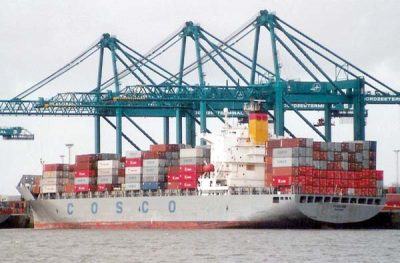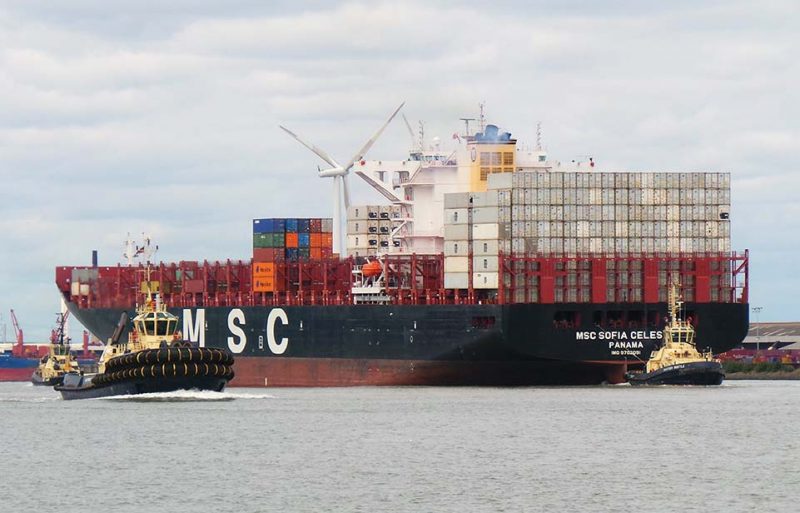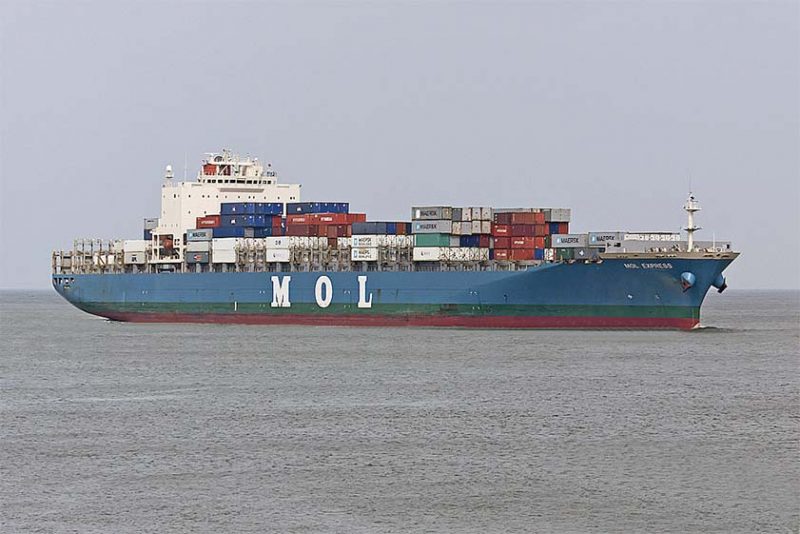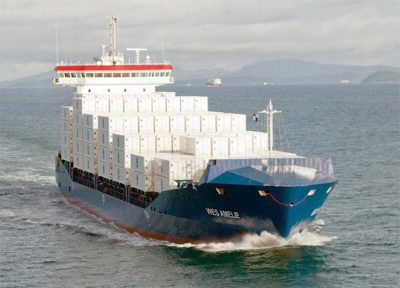APL has set up a new weekly service, the India Pakistan Europe (IPE) Service, that will connect India and Pakistan to major ports in Europe. The first eastbound sailing was on 1st October from Southampton and the first westbound was on 4th October from Port Qasim. The IPE service will call the ports of Port Qasim (Pakistan), Nhava Sheva, Hazira, Mundra (India), Jeddah (Saudi Arabia), Djibouti (Djibouti), Southampton, Rotterdam, Antwerp, Felixstowe and Le Havre. From 14th October APL launched the Andino Service (ANS), a new weekly regional service expected to enhance connectivity between West Coast South America and major ports in Asia and the USA. Commencing from San Antonio, the ANS service calls at San Antonio (Chile), Callao (Peru), Guayaquil (Ecuador), Buenaventura, Manzanillo, Kingston (Jamaica), Cartagena and Balboa.
CMA CGM: In September the company decided to postpone the delivery of certain vessels until 2017 and reduce its capital expenditure commitment as part of a plan to improve operating performance, which includes a programme to reduce costs by $1 billion over the next 18 months. CMA CGM saw its net loss deepen from $100 million reported in the first quarter of 2016 to a net loss of $109 million for the second quarter of 2016, and against a net profit of $156 million seen in the second quarter a year earlier. NOL is also now a wholly-owned subsidiary of CMA CGM and has been delisted from the Official List of the Singapore Exchange Securities Trading Limited (SGX-ST). Classification society DNV GL, CMA CGM (and its subsidiary CMA Ships) and Gaztransport & Technigaz (GTT), maker of LNG containment systems, have signed a co-operation agreement with new project participants ABB, Caterpillar’s Solar Turbines, and OMT for phase two of the PERFECt project. The Piston Engine Room Free Efficient Containership (PERFECt) project investigates the possibility of using a combined gas and steam turbine system (COGAS) to power an ultra large container vessel (ULCS). The aim of the second phase of the project is to detail the technical concept and the commercial feasibility. The project’s phase two will build on the results of the original study which was launched in 2015. Some of the focus areas are process technology optimization of the COGAS system including the steam turbine, use of the available cooling capacity of the LNG, and further optimization of the ship design to attain greater efficiency and increased cargo capacity. In phase one of the project GTT, CMA CGM (and its subsidiary CMA Ships) and DNV GL released a technical and feasibility study for a COGAS-powered LNG-fuelled electrically driven mega boxship. Based on the results of that study, the PERFECt vessel design was found to offer potentially increased cargo capacity, greater layout flexibility and reduced maintenance costs than comparable conventionally powered (heavy fuel oil) HFO and LNG designs, DNV GL said. According to the study, an engine room would not be needed anymore. The three electric main motors, which are arranged on one common shaft, can be run fully independently of each other providing increased redundancy and reliability and a high level of safety.
COSCO HOLDINGS scrapped five containerships between July and August for Yuan90m ($13.5m). Net losses from the disposal stood at Yuan341 million ($51.1 million). The five ships were the 3,324 TEU Na Xi He, 3,400 TEU Bu Yi He, 3,248 TEU Yu Gu He (above), 3,400 TEU Ha Ni He and 3,400 TEU Jing Po He. All the ships, with a combined tonnage of 224,560 dwt, were built in 1997 and owned by a subsidiary of the company, Shanghai Panasia Shipping.
CROWLEY MARITIME CORPORATION launched a new, weekly, fixed-day container shipping service between Jacksonville and Costa Rica on 17th August. The company has deployed two containerships on the service, which calls at the Jacksonville Port Authority’s Talleyrand Terminal on Thursdays, Port Everglades, Florida, on Fridays, and arrive in Puerto Limon, Costa Rica, on Wednesdays.
JIANGSU OCEAN SHIPPING of China has ordered three 1,900 TEU containerships from its native shipbuilder Jiangsu New Yangzijiang Shipbuilding. The contract was signed in September with the 171.9 million long/28.4m beam ships due for delivery from December 2017 to February 2018.
KAWASAKI KISEN KAISHA (K LINE) has launched two new Asia/India/Pakistan services known as the PMX and PIX services. The port rotation of the new PMX (SWACOK1) service includes Qingdao, Shanghai, Ningbo (China), Singapore (Singapore), Port Kelang (Malaysia), Karachi (Pakistan) and Mundra (India), Colombo (Sri Lanka), Singapore and Qingdao. The PMX service started on 28th August from Qingdao with K Line deploying six 4,200 TEU containerships on the route. The port rotation of the PIX (SWACO-K2) service is as follows:- Fuzhou, Hong Kong, Nansha, Shekou (China), Singapore (Singapore), Port Kelang (Malaysia), Colombo (Sri Lanka), Karachi (Pakistan), Mundra (India), Port Kelang, Fuzhou. This service commenced on 8th September from Fuzhou with five 4,200 TEU ships being assigned to this operation.
MAERSK LINE has set up a new service, the TP1, between Asia and the West Coast of the USA, effective 15th September. As part of the service, six vessels of 4,000 TEU will be deployed per week. The TP1 service will form part of the 2M alliance’s network of services. The TP1 Eastbound service covers Yantian, Shanghai (China), Busan (South Korea), Los Angeles/Long Beach (USA), while the port rotation of the TP1 Westbound service will be Los Angeles/Long Beach, Yantian, Shanghai, Busan. The move is in response to Hanjin’s decision to seek court receivership, a situation that has triggered a global supply chain crisis. Similarly, 2M partner MSC announced the introduction of a new transpacific service called Maple which also started on 15th September. The latter service calls at Busan, Shanghai, Yantian, Prince Rupert, Busan and consists of six vessels of 5,000 TEU capacity.
MATSON, a U.S based container carrier, announced in late August that its subsidiary Matson Navigation had ordered two new combination container and roro (ConRo) vessels for a total cost of $511 million. The deal is with General Dynamics NASSCO and delivery is expected by the end of 2019 and by mid- 2020. Matson specialises in Pacific routes, primarily to Hawaii but also to Alaska, Guam, Micronesia and Alaska, Guam, Micronesia and some South Pacific islands. These two new orders will be for the Hawaiian fleet and they’ve been dubbed the Kanaloa Class, a reference to a sea god in the traditional religion of Hawaii.
MC SEAMAX an American based tonnage provider, has purchased the 94,784gt/2014 built UASC Umm Qasr for $80m. The deal for the Hyundai Samho-built ship includes a charter back at $39,500 a day through to early 2018. UASC, which has debts of $4 billion, has been opting for larger 18,000 TEU ships and the fleet will also be rationalised in the near future following the merger with Hapag-Lloyd.

MSC launched a new weekly container service connecting East Africa, Middle East, Pakistan and India, the Cheetah Service, in September, deploying five 2,200 TEU vessels onto the route. The Cheetah service offers direct calls to Mombasa (Kenya), Dar es Salaam (Tanzania), Mogadishu, Kismayo (Somalia). The port rotation includes Jebel Ali (UAE), Karachi old port (Pakistan), Mundra, Nhava Sheva (India), Salalah (Oman), Mombasa (Kenya), Dar es Salaam (Tanzania), Mogadishu, Kismayo (Somalia) (every 3 weeks) and Jebel Ali. The first sailing was on 7th September when the 25,713gt/1997 built MSC Positano departed from Jebel Ali. MSC’s 95,497gt/2015 built neo-panamamax vessel MSC Sofia Celeste (above) made her inaugural call at the London Container Terminal in Tilbury during the week beginning 15th August. The 8,800 TEU capacity ship is the first in a new class of vessels deployed on a reconfigured service connecting the West Coast of S.America, East Coast of North America and Northwest Europe and is the first to call into the UK having transitted the new Panama Canal.
THE OCEAN ALLIANCE companies have encountered another hurdle as the US Federal Maritime Commission (FMC) asked for more information in August before giving its approval for the process. The Ocean Alliance agreement, which was filed on 15th July, was therefore stopped in its tracks until such time as the filing parties answer the questions proposed in the RFAI. Once the questions are answered and filed with the Commission, a new 45-day clock commences to lay the foundations for the Ocean Alliance and give the go-ahead, or not. The proposed alliance, which consists of CMA CGM, COSCO Shipping, Orient Overseas Container Line and Evergreen, is looking to deploy increased ocean carrier services from Asia to the US East and Gulf Coast ports starting from April 2017.
SAMSKIP completed the acquisition of Euro Container Lines AS (ECL) in late August, building on a strategy for growth in the Nordic area to make its largest ever acquisitive move in Norway. The ECL purchase aims to strengthen Samskip’s position in the Norwegian market by enhancing the speed and frequency of services delivering a second- to-none value proposition for its Norwegian client base. Total annual Norwegian Samskip volumes are expected to increase substantially, from the current 55,000 TEU to 90,000 TEU, increasing overall annual volumes from 850,000 TEU to 885,000 TEU. The acquisition also means a significant expansion in the refrigerated transport capacity Samskip can offer connecting with its own cold stores in Ålesund and Rotterdam, which increases to around 275-300 reefer containers per week. Samskip will be serving 14 ports in total, and possibly calling at additional ports on an inducement basis, where Holla, Ikornes, Maløy and Haugesund will be new additions to the Samskip network. With a fixed twice-weekly sailing schedule ex-Rotterdam and two additional fixed sailings ex-Hamburg, Samskip will increase total frequency to 3-4 sailings per week into Norway, depending on seasonal demand.
SEASPAN sent the 53,822gt/2003 built and 3,700 TEU capacity MOL Express (above) for scrapping in August. The ship had run aground in Japan but was a mere 13 years old. Seaspan also sent another 13-year-old Panamax containership, the 53,822gt/2003 built Seaspan Excellence, for scrap that month.
WESSELS REEDEREI will become the first company to convert a containership to use LNG as a fuel. The 10,585gt/2011 built and 1,036 TEU Wes Amelie (above) will be converted in a project that is sponsored by the German ministry of transport. Partners in the project include MAN Diesel & Turbo, TGE Marine Gas Engineering, SMB Naval Architects & Consultants and Bureau Veritas. The vessel has a MAN 8 L 48/60B engine driving a controlled pitch propeller via gearing. MAN will convert the existing engine to a 51/60 DF dual-fuel engine. The LNG tank of about 500 cubic metres will be located in the fore part of the vessel to limit the loss of cargo capacity. Following the conversion the Wes Amelie will meet Tier III of Marpol Annex 6 regulations.







Comments
Sorry, comments are closed for this item